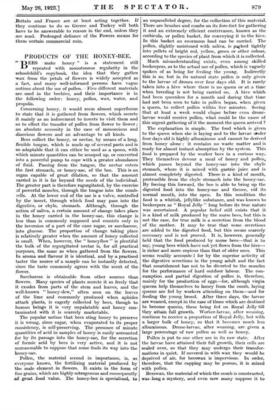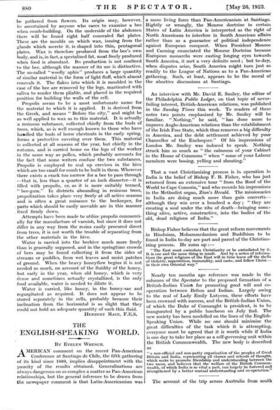PRODUCTS OF THE HONEY-BEE.
IBTBS make honey " is a statement still U repeated with monotonous regularity in the -schoolchild's copybook, the idea that they gather ,wax from the -petals of flowers is widely accepted as a fact, and many well-informed persons have vague notions about the use of pollen. - Five different materials -are -used -in the beehive, and their importance is in the following order : honey, pollen, wax, water, and propolis.
Concerning honey, it would seem almost superfluous to state that it is gathered from flowers, which secrete ,it mainly. as an inducement to insects to visit them and so to effect the transfer of pollen from flower to flower ; an absolute necessity in the case of monoecious and ,thoecious flowers. and an advantage to all kinds.
Bees collect the honey, or nectar, by means of a kong, flexible tongue, which is made up of several parts and is so adaptable that it can either be used as a spoon, with which minute quantities can -be scooped up, or converted into a powerful pump to cope with a greater abundance of fluid. Passing from the tongue, the nectar enters the. first stomach, or honey-sac, of -the bee. This is an organ capable of great dilation, so that the amount carried in it is far beyond the needs of the. individual. The greater part is therefore regurgitated, by the exercise of powerful muscles, through. the tongue into the comb- cells. At the lower -end of the sac is a valve, controlled by the insect, through which food may pass into the .digestive, or chyle, stomach. Although, through the action of saliva, a certain -amount< of change takes place in the honey carried in the honey-sac, this -change is less than is commonly supposed and consists only in the inversion of a part of the .cane sugar, or saccharose, into glucose. The proportion of change taking place is relatively greater when the amount of honey collected is small. 'When, however, the " honeyflow -" is plentiful the bulk, of the regurgitated nectar is, for all, practical purposes, the , same as when ,gathered from the flowers. In aroma -and 'flavour -it is identical, and by a practised taster the source of a sample can be instantly detected, since the taste commonly agrees with the scent of the flower.
Saccharose is obtainable from other sources than flowers. Many species of plants secrete it so freely that it exudes from parts of the stem and leaves, and the well-known " honey-dew," often seen on the leaves of the lime and commonly produced when aphides attack plants, is eagerly collected by bees, though to human beings it is very unpalatable and honey con- taminated with it is scarcely marketable.
The popular notion that bees sting honey to preserve it is wrong, since sugar, when evaporated to its proper consistency, is -self-preserving. The presence of minute quantities of acid in samples of honey is easily accounted for by its passage into the honey-sac, for the secretion of formic acid by bees is very active, and it is not =reasonable to suppose that some finds its way into the honey-sac.
Pollen, the material second in importance, is, as :everyone knows, the fertilizing material. produced by The male-.element. in flowers. It-exists in the form of fine grains, which are highly nitrogenous and consequently ltd. great. loud value. ..The honeybee is, specialized, to. an unparalleled degree, for the collection of this material. There are brushes and combs on its fore-feet for gathering it and an extremely efficient contrivance, :known as the corbicula, or pollen basket, for conveying it to the hive.
In this basket an enormous load can be carried. The pollen, slightly moistened with saliva, is packed tightly into pellets of bright red, yellow, green or other colour, according to the species of plant from which itis collected.
Much misunderstanding exists, even among skilled beekeepers, as to the actual use of pollen, which is vaguely spoken of as being for feeding the young. Indirectly this is so, but in its natural state pollen is only given to the larvae of drones over four days old. It is rarely taken into a hive where there is no queen or at a time when breeding is not being carried on. A hive which had been queenless for a month and during that time had not been seen to take in pollen began, when given a queen, to collect pollen within five minutes. Seeing that at least a week would elapse before even drone- larvae would receive pollen, what could be the cause of this urgent gathering of it the moment the queen arrived ? The explanation is simple. The food which is given to the queen when she is laying and to the larvae under four days old is highly albuminous and cannot be derived from honey alone : it contains no waste matter and is ready for almost instant absorption by the system. This food is prepared by the worker bees in a curious way. They themselves devour a meal of honey and pollen, which passes beyond the honey-sac into the chyle stomach, where it is mixed with gastric juice and is almost completely digested. There is a kind of mouth, protrusible from the chyle stomach into the honey-sae.
By forcing this forward, the bee is able to bring up the digested food into the honey-sac and thence, vid its normal mouth, into the open. In this condition the food is a whitish, jellylike substance, and was known to beekeepers as " Royal Jelly " long before its true nature was ascertained. A popular belief still exists that it is a kind of milk produced by the nurse bees, but this is not the case, for true milk is a secretion from the blood of the mother. It may be true that some secretions are added to the digested food, but this seems scarcely necessary and is not proved. It is, however, generally held that the food produced by nurse bees—that is to say, young bees which have not yet flown from the hive— is richer and more copious than that of older ones. This seems readily accounte I for by the superior activity of the digestive secretions in the -young adult and the fact that nourishment has not to be diverted to the muscles for the performance of hard outdoor labour. The con- sumption and partial digestion of pollen is, therefore, mainly for the production of eggs—for, although virgin queens help themselves -to honey from the comb, laying queens are fed by workers attending on them—and for feeding the young brood. After three days, the larvae are weaned, except-in the .case of those which are.destined to become queens, these being fed on Royal Jelly till they attain full growth. Worker-larvae, after weaning, continue to receive a proportion of Royal Jelly, but with a larger bulk of honey, so that it becomes much less albuminous. Drone-larvae, after weaning, are given a large percentage of raw pollen as well as honey.
Pollen is put to one other use in its raw state. After the larvae have attained their full growth, their cells are sealed over, so that they may undergo their transfor- mations in quiet. If covered in with wax they would be deprived of air, for beeswax is impervious. In order, therefore, that the capping may be porous, it is mixed with pollen.
Beeswax, the material of which the comb is constructed, was .long a mystery, and even now many suppose it to . be gathered from flowers. Its origin may, however, be ascertained by anyone who cares to examine a bee when comb-building. On the underside of the abdomen . there will be found eight half concealed flat plates.
These are the moulds on which wax, issuing from the glands which secrete it, is shaped into thin, pentagonal plates. Wax is therefore produced from the bee's own body, and is, in fact, a specialized fat, most freely produced when food is abundant. Its production is not confined - to the bee, although the manner of its use is distinctive. - The so-called "woolly aphis" produces a large quantity of similar material in the form of light fluff, which almost conceals it. The flakes into which it is moulded in the case of the bee are removed by the legs, masticated with saliva to render them pliable, and placed in the required • position for building the walls of the cell.
Propolis seems to be a most unfortunate name for the material to which it is applied. It is derived from the Greek, and means " Before the city," and might be as well applied to wax as to this material. It is actually a resinous substance, collected chiefly from the buds of trees, which, as is well enough known to those who have • handled the buds of horse chestnuts in the early spring, forms a protective covering over them. This material is collected at all seasons of the year, but chiefly in the autumn, and is carried home on the legs of the worker . in the same way as pollen, which probably accounts for the fact that some writers confuse the two substances. Propolis is employed to seal up crevices in the hive which are too small for comb to be built in them. Wherever there exists a crack too narrow for a bee to pass through —that is, less than a quarter of an inch diameter—it is • filled with propolis, or, as it is more suitably termed, " bee-gum." In districts abounding in resinous trees, propolization takes place very freely at all active seasons and is often a great nuisance to the beekeeper, for parts which should be easily movable are in this manner . fixed firmly down.
Attempts have been made to utilize propolis commerci- ally for the manufacture of varnish, but since it does not differ in any way from the resins easily procured direct from trees, it is not worth the trouble of separating from the other materials in the hive.
Water is carried into the beehive much more freely -than is generally supposed, and in the springtime crowds of bees may be found collecting it from the sides of streams or puddles, from wet leaves and moist patches of ground. When the heavy honeyflow begins it is not needed so much, on account of the fluidity of the honey, but early in the year, when old honey, which is very dense and sometimes actually crystallized, is the only food available, water is needed to dilute it.
Water is carried, like honey, in the honey-sac and regurgitated as required. It does not appear to be stored separately in the cells, probably because their inclination from the horizontal is so slight that they could not hold an adequate quantity of such thin fluid.
HERBERT MACE, F.E.S.











































 Previous page
Previous page